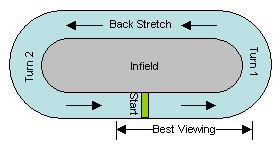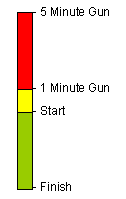How to Watch

Where to Sit |
|
| One of the best parts of a boat race is to relax in your chair and enjoy the race. There can be some down time between heats that you can enjoy the outdoors or visit with the people around you. The best thing to do during these periods is visit the vendor booths. These vendors help pay for the race to keep your entry and parking low. | |
 |
Finding a good seat is not hard. Look for a location along the straight away side of the course just to the left of the starting line or the clock. Anywhere between here and the first turn where all the action takes place is excellent. Notice where the sun is and how it will move across the sky during the day. Although a nice shady spot may look good when you first arrive, what you really want to look for is a shady spot for the afternoon in the heat of the day. An umbrella can provide portable shade when there are no trees. Pay attention to the direction of the wind, so that you are not blocked from any wind on a hot summer day. |
Time During the RaceThere is a 5 minute gun to signal that it is time for the boats to leave the pits. This gives the engine time to get up to temperature for the race. The prudent driver will make a timing run or two, such as from the second turn to the staring line during this prestart period. Just prior to the one minute gun, the drivers are jockeying for poll positions. When the one minute gun goes off, the drivers have to maintain their respective lanes or poll position. At this point the boats should be around the exit of turn one. The farther beyond that point, the more they must slow down to prevent jumping the gun or crossing the staring line too early. The object being to reach the starting line when the clock counts down to zero and be at full speed. Once the race has started, the clock will count up rather than counting down as it did prior to the start. |
 |
The Flying StartThe flying start is unlike any other motorsport. It is spectacular to see as many as 12 boats abreast all flying across the starting line at full speed. The turns are marked with large orange buoys and the starting line is marked with two checkered buoys on either end of it. The drivers must time their approach to cross the starting line when the clock has counted down to zero. The lane or poll position established must be maintained down the front straightaway to the exit of turn 1 during the start. When the boats enter the first turn, this is where the most action is likely to occur. You want to make sure that you have a clear view of the first turn. |
|||||||||
Rooster TailsThat long plume of water behind the boats is called the rooster tail. When the boats turn, the skid fin on the left side of the boat digs in and sends up a second rooster tail. All this water up in the air makes it difficult for the officials to see what is going on in the turns. |
 |
||||||||
| This is an important factor for a driver changing lanes. They must not cross toward the inside lanes, without being at least 4 boat lengths or one rooster tail ahead of the boat they are passing. When a driver crosses a rooster tail, the driver is totally blinded by the spray of water on the cockpit. This powerful rooster tail can cause a boat to go airborne and fly over backwards or do a barrel roll flip. If a driver is lucky enough to cross through a rooster tail right side up, then there is still the possibility that an unseen boat will be there causing a collision. For these reasons, a driver will avoid crossing a rooster tail, if at all possible. | |||||||||
The Race CourseAs with other motorsports, the inside lane is the most desirable. This is the shortest distance around the course. The length of the race is a 5 miles, but the size of the course may vary. |
|||||||||
|
All buoys marking the inside of the race course must be passed on the driver's left side. If not, then the driver must go back and pass the buoy on the correct side. If a driver touches a buoy without any damage, they may continue. However, if the buoy is dislodged, deflated, or otherwise damaged, then the boat is disqualified. If a driver jumped the gun, then they will not know until the end of the race. They will not receive a checkered flag after 5 miles and be required to take an extra lap. In order for a driver to set a National or World Record, the course must be accurately surveyed prior and during the race. Should a record be set, then the boat must undergo an official inspection. | ||||||||
|
